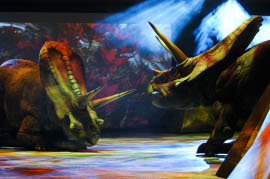 The
irony might be a little obvious, but extinct dinosaurs have helped
stave off extinction for another animal: the creator of animatronic
creatures.
The
irony might be a little obvious, but extinct dinosaurs have helped
stave off extinction for another animal: the creator of animatronic
creatures.
Animatronics is "one of those arts that's probably dying out," said Sonny Tilders, the creature designer and builder for Walking with Dinosaurs: The Live Experience, coming to the i wireless center March 5 through 9.
Tilders, the founder of Melbourne, Australia's Creature Technology Company, has worked on such films as Star Wars Episode III: Revenge of the Sith and The Chronicles of Narnia: The Lion, the Witch, & the Wardrobe. His field, he said in a phone interview last month, has become "less demanding and less challenging and less frequent, to be honest, in the film world."
But he doesn't sound despondent that computer-generated imagery (CGI) has largely displaced animatronics in movies. CGI has taken over many of the wide shots in film and TV, and it makes it easy to erase elements such as wires. "You're kind of helped out in a way," Tilders said.
Animatronics, he admitted, is "probably not the most practical way to solve a lot of problems. And in the end that's all it is: It's just a tool to solve problems. Fortunately for us, there's no alternative for live theatre; it's the only way to do it."
Based on the 1999 BBC television series, Walking with Dinosaurs: The Live Experience opened in Australia in 2007 and features 15 life-sized dinosaurs, some as large as 36 feet tall and 56 feet long. The 96-minute show, in which a paleontologist guides the audience through 200 million years, is geared to family audiences and features no violence.
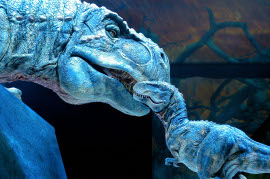 Live-theatre
animatronics have always been more difficult than those for film,
Tilders said. "The deal with film and TV is you've got a frame,
and it blocks out all the stuff you don't want to see," he said.
"For a live stage show, you've got none of that assistance. You
can't afford to have 20 puppeteers trailing behind holding cables,
or a huge hydraulic compressor linked via enormous lines running
behind the dinosaur. We had to make these things autonomous, and
self-propelling, and self-contained."
Live-theatre
animatronics have always been more difficult than those for film,
Tilders said. "The deal with film and TV is you've got a frame,
and it blocks out all the stuff you don't want to see," he said.
"For a live stage show, you've got none of that assistance. You
can't afford to have 20 puppeteers trailing behind holding cables,
or a huge hydraulic compressor linked via enormous lines running
behind the dinosaur. We had to make these things autonomous, and
self-propelling, and self-contained."
That challenge was exacerbated by the arena nature of Walking with Dinosaurs. Unlike the stage versions of The Hobbit and The Lion, the Witch, & the Wardrobe for which he provided puppetry, Walking with Dinosaurs has the equivalent of a thrust stage, with the audience on three sides. "They're very much exposed," Tilders said of the dinosaurs. "We can't really mask much. We can't hide behind anything. ... We're out there. People can see us from all angles."
The dinausaurs "move" through the arena on T-shaped platforms, Tilders said. "Using the camouflage to blend them into the floor, pretty soon after they enter people ignore this thing underneath and start, at least for a few seconds, believing that these things may actually exist," he said. "The audience will go with you. ... They'll suspend disbelief and they'll invest their imagination into the puppet and ignore the performer or the operator - if you do the puppetry well enough."
Of course, dinosaurs did exist, but the goal is to make audience believe that they still do.
"We did our best to be as truthful as we could to the latest scientific, paleontological evidence," Tilders said. "We build our dinosaurs from the ground up, from the bone structure through to the speculation on the muscle structure, and then you get further into less-known things like skin details and certainly color. There's only just the tip of evidence suggesting some of the colors or bandings that appeared on some of those dinosaurs. ... But even then, we put a rationale behind the color choices. If it's a herbivore, it may need camouflage. If it's an animal that relies on display for protection - intimidation - you might put really striking colors on it.
"It's based on scientific fact; it's not pure fantasy."
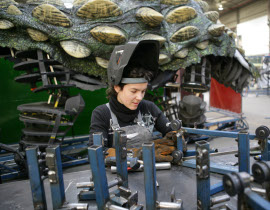 The
design process began by sculpting miniatures - on a one-twentieth
scale - based on reconstructions and artists' interpretations of
dinosaurs. That establishes the basic body shape.
The
design process began by sculpting miniatures - on a one-twentieth
scale - based on reconstructions and artists' interpretations of
dinosaurs. That establishes the basic body shape.
"When we're happy with that design," Tilders said, "we scan the model ... so it becomes a virtual 3D model, and then quite literally we can slice that 3D virtual model up into sections - in our case 150 millimeters apart - and essentially ... CT scan the entire creature. And then blow those sections up to the correct scale and then it's just a matter of putting them back together in the correct order, and you've got a 15-meter-long T. rex. So after you've done that initial sculpt, it becomes almost sculpting by numbers."
Then come the bones. "The dinosaur has several hundred bones," Tilders said, "and of course we have to make decisions about rationalizing those bones down to ones that make sense. There's no point in over-complicating the system. So my job is to rationalize those points of movement down, and in the end we have 24 to 30 axes of movement for each dinosaur" - which could affect an eyelid or the animal's entire body.
Although there's no staff paleontologist for Walking with Dinosaurs: The Live Experience, Tilders said that building the creatures has helped him understand their biology.
"We're discovering as we go that these things are in these positions for a reason," he said.
And if the designers and builders are having difficulty with a movement, chances are good the dinosaur itself did, too. The stegosaurus, for instance, has plates on its back that tend to knock against each other. "We're finding that it [the animatronic dinosaur] flexes very nicely left to right, but of course it has trouble looking up and looking down ... ," Tilders said. "It would be fair to say the creature itself ... struggled to do the same."
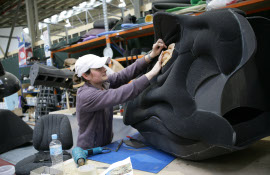 On
Walking with Dinosaurs,
Tilders had to deal with issues that he never encountered on a film
set. For example, with movie animatronics you need something to "last
a few days. This is a few years."
On
Walking with Dinosaurs,
Tilders had to deal with issues that he never encountered on a film
set. For example, with movie animatronics you need something to "last
a few days. This is a few years."
So the dinosaur skin needed to be durable, but also stretchy and lightweight "because of the enormous surface areas of skins. ... It has a top-down effect. The heavier you make the skin, the heavier you have to make the structures underneath that support it, the heavier the steel framework has to be, the more powerful the hydraulic cylinders have to be, the bigger the pump has to be, ... and the more batteries we have to carry on board.
"A few percent at the external end - the skin end - can make a huge difference down the line," he continued. The skin "was one of first paths of development. ... Certainly that was one of the greater challenges. Most people think it must be a technical, electronic, robotic, sort of problem, but that soft end of animatronics is just as critical."
Another area of development was the use of muscle bags - netting in the shape of muscles filled with polystyrene beads - under the skin. "They're a lightweight way of giving you body forms in flexible, strechable costumes," Tilders said.
And the show's engineer developed a valving system that gave a more natural look to movement powered by hydraulics. Hydraulic systems, Tilders said, are "designed to be very, very powerful ... but not necessarily fluid and organic in the way they move."
He acknowledged that designing and building dinosaurs is in some ways less difficult than a creature that never existed. "It's easier in that the designs are there for you," he said. "Essentially you have a template to work from."
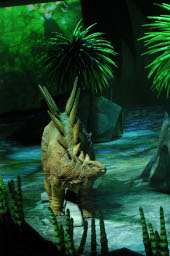 But
he noted that the challenge of animatronics - and
computer-generated imagery - is to convince audiences that this
fundamentally fake thing is made of flesh and blood.
But
he noted that the challenge of animatronics - and
computer-generated imagery - is to convince audiences that this
fundamentally fake thing is made of flesh and blood.
"People still expect that same level of realism that stems from an understanding of physics and understanding of the biology we see around us," Tilders said. "I think people have more of an intuitive understanding of these sorts of things than we give them credit for; I think people can see when something doesn't look believable."
One advantage of animatronics, he added, is that the creations must abide by the laws of physics. With computer-generated imagery, he said, "they have to invent the physics; they're not bound by physics." The result, he said, is that "we get used to a cartoon style of reality."
And even though they are increasingly rare in film, Tilders said that audiences have an appreciation for the tangibility, presence, and impact of animatronics, whether it's on the screen or at the i wireless Center. "I think people really enjoy the fact that something is physically made ... ," he said. "I think people are more forgiving of animatronics because they know that it actually existed."
For a video of dinosaur construction, visit (http://www.youtube.com/watch?v=OtfMIiinJso).
Walking with Dinosaurs will be performed seven times from March 5 through 9. For tickets and performance information, visit (http://www.iwirelesscenter.com). For more information on the show, visit (http://www.dinosaurlive.com).










